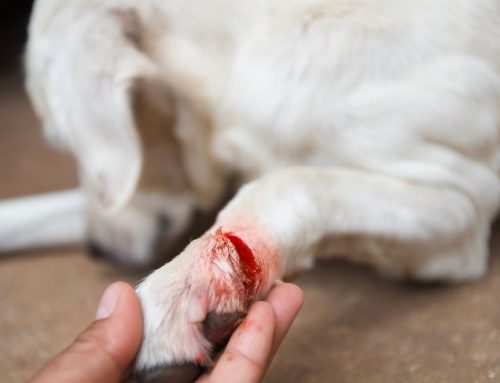Many parasites can cause problematic health issues for your pet, and some can affect you and your family. Our team at Countryside Veterinary Hospital wants to help by providing information about parasitic diseases in pets, and ways you can safeguard your four-legged friend.
Roundworms in pets
Roundworms are the most common parasites that affect pets, and most pets become infected at some point in their life, usually when they are puppies or kittens. Roundworm facts include:
- Transmission — Roundworms can be transmitted in several ways:
- Mother pets can pass roundworms to their puppies and kittens before they are born.
- Young pets can be infected when they drink their mother’s milk.
- Pets can be infected when they eat larvated eggs in their environment.
- Pets can get roundworms if they eat an infected mouse or other small mammal.
- Signs — Roundworms live in the pet’s intestine and leach nutrients. Healthy, adult pets typically don’t show any roundworm infection signs, but young pets and immunocompromised pets can show signs that include diarrhea, vomiting, weight loss, a dull hair coat, and a pot-bellied appearance.
- Diagnosis — A routine fecal check can detect roundworms.
- Treatment — Treatment involves administering an appropriate deworming medication.
- Risk to humans — Roundworms can infect humans who contact contaminated soil or fecal matter, and can cause eye, lung, heart, and neurological problems.
- Prevention — Remove fecal matter from your pet’s environment regularly, and don’t allow them to eat wild animals. In addition, your veterinarian should perform a fecal check on your pet at least once a year.
Heartworms in pets
Heartworms are common in pets throughout the United States, and have been diagnosed in every state. Heartworm facts include:
- Transmission — Heartworms are transmitted through an infected mosquito’s bite. Dogs and wild canids, such as wolves, coyotes, foxes, and raccoons, are natural hosts for heartworms. When a mosquito takes a blood meal from an infected natural host, the parasite matures inside the mosquito, and can be transmitted to another pet when the mosquito feeds on them.
- Signs — Many pets don’t show signs initially, but as the disease progresses, signs in dogs typically include a soft cough, lethargy, exercise intolerance, and weight loss, and in cats include wheezing, panting, and difficulty breathing. Severely infected pets may collapse or die suddenly.
- Diagnosis — A heartworm diagnosis requires a blood test, and chest X-rays or ultrasound may be necessary.
- Treatment — Heartworm disease treatment in dogs must be managed extremely carefully, because killing the worms can result in severe, potentially life-threatening, inflammation in the pet’s lung vasculature. Affected dogs are restricted from exercise, since activity can exacerbate the worm’s damage, and their condition must be stabilized before they can be medicated to kill the worms. No treatment is available for heartworm disease in cats, and management focuses on decreasing the inflammation caused by the worms, plus supportive care.
- Risk to humans — Heartworms are not considered a threat to humans, but rare cases have been reported.
- Prevention — Pets should receive year-round heartworm prevention medication to protect them from these dangerous parasites, and yearly heartworm tests are recommended.
Sarcoptic mange in pets
Sarcoptic mange is caused by microscopic Sarcoptes scabiei mites in dogs and Notoedres cati mites in cats that feed on the pet’s skin. Sarcoptic mange facts include:
- Transmission — Transmission occurs when a pet directly contacts an infected pet.
- Signs — Sarcoptic mange is extremely itchy, and signs include excessive scratching, hair loss, and red, scaly skin lesions, typically at the ears, elbows, and abdomen.
- Diagnosis — Mites can be hard to find, although a skin scraping can detect them in some cases. A medication trial can also be used to diagnose suspected sarcoptic mange cases.
- Treatment — Treatment involves clipping the pet’s hair, using topical applications to kill the mites, and administering medications to control the itchiness.
- Risk to humans — Sarcoptic mange can be transmitted to humans, but the condition typically resolves without treatment.
- Prevention — Ensuring your pet is not exposed to infected pets is the best prevention for sarcoptic mange.
Toxoplasmosis in pets

Toxoplasmosis can affect most animals, but cats are the natural host, meaning the parasite can complete their life cycle while parasitizing the cat. Toxoplasmosis facts include:
- Transmission — Cats are infected by toxoplasmosis when they eat infected small mammals, and dogs are infected when they eat infected cat feces or nose around in contaminated soil.
- Signs — Healthy, adult pets usually don’t exhibit signs, but young pets and immunocompromised pets may show signs that include fever, diarrhea, muscle weakness, decreased appetite, difficulty breathing, and eye inflammation.
- Diagnosis — Diagnosis typically involves a blood test to detect the pet’s immune response.
- Treatment — Most pets don’t require treatment, but antibiotics and antiparasitics may be administered if necessary.
- Risk to humans — Toxoplasmosis can be transmitted to humans, but is not typically a problem for healthy adults. Flu-like symptoms can occur in people who have a weakened immune system, and toxoplasmosis can significantly damage developing babies, so pregnant women are at increased risk.
- Prevention — Ensure your cat doesn’t eat wild animals, clean their litter box frequently, and wash your hands thoroughly after handling their litter.
Parasitic diseases can be problematic for you and your pet, but the proper precautions can prevent most conditions. If you want to ensure your pet is parasite-free, contact our team at Countryside Veterinary Hospital, so we can test them for parasitic diseases.








Leave A Comment